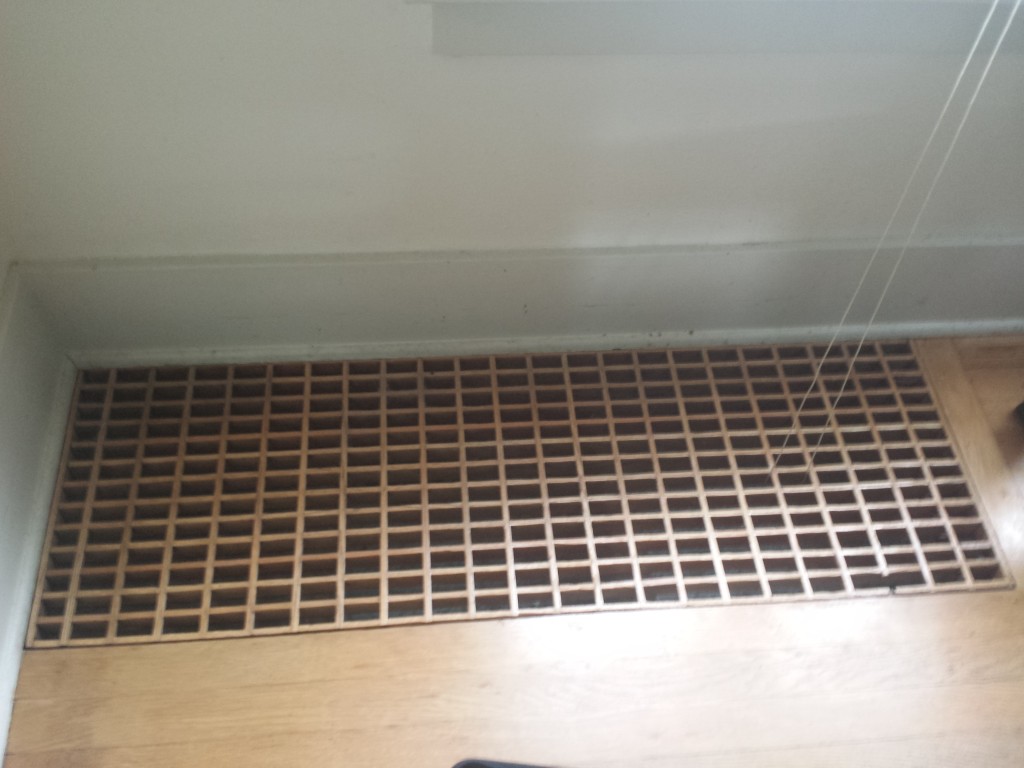Asbestos is a concern for indoor air quality and respiratory health, and most people know the common places that it can be found (popcorn ceilings, vinyl tiles, pipe insulation). But did you know that asbestos-containing tapes and wraps were often placed directly inside of the heating vents in older homes? Hiring a licensed AHERA building inspector to check your heating vents for asbestos-containing materials can reveal hidden dangers that you may have been unaware of. The following is a brief case study from an inspection that we recently performed.
Background Information
The client had an energy audit performed, and PACM (potentially asbestos-containing materials) were identified on the HVAC ducting.
Property Description
The subject property is a 1,040 square foot single-family home originally constructed in 1927.
Summary
Based on the results of the samples listed below, the tape on the outside of the HVAC ducting, the tape within the noted HVAC supply boots, and the white
boards above the HVAC ducts are asbestos-containing materials. These materials are all somewhat damaged and should be considered friable. The materials
should be either abated or encapsulated by a certified asbestos abatement contractor.
Lab Analysis
All samples included in this report were analyzed by Aerobiology Laboratory Associates, Incorporated in Denver, Colorado (NVLAP Certification number
200860-0). The samples were analyzed using polarized light microscopy/dispersion staining (PLM), a method for the determination of asbestos in bulk building
materials (EPA-600/R-93/116 July 1993).
Please see the included PDF document for additional information regarding analysis and layers included in each sample.
ASBESTOS TESTING
Homogeneous Sampling Area : ANW-01
Description of material: White fibrous tape
Color: White
Pattern: Woven
Condition: Damaged (see specifics below)
Category: Miscellaneous
Locations: See the red areas of the basement floor plan and the descriptions below
Number of samples taken: 1
Sample ID number: ANW-01-01
Result: This material contains 90 percent chrysotile asbestos.

Homogeneous Sampling Area : ANW-02
Description of material: White boards
Color: White/tan
Pattern: None
Condition: Damaged (exposed fibers at ends where it had been cut for installation)
Category: Miscellaneous
Locations: Between HVAC supply ducts and wood framing in the basement (see the yellow areas of the basement floor plan)
Number of samples taken: 1
Sample ID number: ANW-02-01
Result: This material contains 85 percent chrysotile asbestos.

Sampling Methodology
Asbestos is a generic name given to a number of naturally occurring hydrated mineral silicates that possess a unique crystalline structure, are
incombustible in air, and are separable into fibers. Asbestos includes asbestiform varieties of chrysotile (serpentine), crocidolite (riebeckite), amosite
(cummingtonite-grunerite), anthophyllite, tremolite, and actinolite. Inhalation of asbestos fibers has been linked to diseases such as asbestosis, lung
cancer, and mesothelioma.
All asbestos sampling performed by Hawk Environmental Services is carried out pursuant to 40 CFR 763.86 as required by both AHERA and ASHARA. All samples
will be collected by an AHERA accredited asbestos building inspector and analyzed by polarized light microscopy by a laboratory accredited by the National
Bureau of Standards (NBS). All asbestos samples are taken under a wet removal method to limit the likelihood of airborne particles being released.
Notes and Terms
Homogeneous Sampling Area
An area of suspected asbestos-containing building materials that appears similar throughout in color, texture, and date of material application.
Thermal System Insulation
Material applied to pipes, fittings, boilers, breechings, tanks, ducts, or other interior structural components to prevent heat loss or gain or water
condensation, or for other purposes.
Surfacing Material
Material that is sprayed on, troweled on, or otherwise applied to surfaces, such as acoustical plaster on ceilings and fireproofing materials on
structural members, or other materials on surfaces for acoustical, fireproofing, or other purposes.
Miscellaneous Material
Interior building material on structural components, structural members, or fixtures, such as floor and ceiling tiles, not including thermal system
insulation or surfacing materials.
Sample Data
HVAC Registers
Each of the HVAC registers was visually inspected (without removing screwed-in grills) to determine if materials consistent with asbestos tape (sample
ANW-01-01) were present. The information gathered is as follows.
Living room supply vent (interior wall):
We found asbestos tape within the ducting at the seams within the supply boot.
The area where the damper contacts the side of the boot shows evidence of frayed and friable asbestos tape.

Living room return vent (floor):
We found no visible PACM (potentially asbestos-containing materials) within the boot or duct.

Dining room supply vent (interior wall):
We observed slight adhesive residues that may be leftover from remaining asbestos-containing tape.
Dining room return vent (floor):
We noted no visible PACM (potentially asbestos-containing materials) within the boot or duct.
Kitchen supply vent (behind refrigerator):
We noted no visible PACM (potentially asbestos-containing materials) within the boot or duct.
This vent appears defunct and simply opens to the basement. When we viewed it from the basement, we observed some remaining asbestos tape.
Kitchen supply vent (under metal pot shelf):
We observed slight remnants of asbestos-containing tape.
Breakfast nook vent (floor):
We noted no visible PACM (potentially asbestos-containing materials) within the boot or duct.
Back bedroom/bathroom supply vent (interior wall):
We noted poorly adhered and friable asbestos-containing tape (painted black) within this boot; it will likely be disturbed if the damper is
adjusted.

Front bedroom supply vent (wall):
We observed slight remnants of asbestos-containing tape.

Basement bedroom supply vent (wall):
We noted no visible PACM (potentially asbestos-containing materials) within the boot or duct.

yellow rectangles = ANW-02
red rectangles = ANW-01
*Crawlspace could not be inspected.
Comments are closed.


